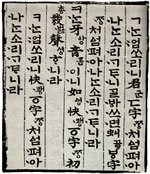| |

2-2-2. Samjae and Change
This Ilgiyae
has no specified form. So it is not even oneness. Therefore it has been said
"principle begins where is not even one."1)
But it includes every skill. Therefore it has been said "body builds numerous
beings."2) Thus Samjae is fundamental
frame of changes of yin/yang, and also of techniques of Kang-Yu.
Let us examine along the logic of <Yeok> how Ilgiyae
becomes the foundational framework of Kang-Yu techniques through Samjae.
 |
|
<Hankeul,
the Korean letter system was invented based on Samjae>
|
It was said in The Great Appendix; ¡°The movements which take place in the six
places (of the hexagram) show the way of the three extremes (i.e. of the three
Powers in their perfect operation)."3)
Here, ¡®the three extremes¡¯ refers to just Samjae.4)
By the way, ¡°Each embraces Samjae; and, being repeated, its full form consisted
of six lines builds a hexagram. A distinction was made of to the yin and yang
lines, which were variously occupied, now by the strong(Kang) and now by the
weak(Yu) forms, and thus the figure (of each hexagram) was completed.¡±5)
It means, a hexagram is a coupled two trigrams and a trigram is composed of
three yin/yangs along the way of Samjae.
Considering them conversely, various changes are symbolized by hexagrams in
I Ching and each hexagram is composed of two trigrams coupled. A trigram
is made of accumulation of three yin/yangs, where three yin/yangs are accumulated
by each owing to yin/yang's following the framework of Samjae. ¡°Accordingly,
the movements which take place in the six places (of the hexagram) show the
ways of three: heaven, earth and man.¡±6)
On the other hand, these trigrams symbolize not only changes of Kang-Yu techniques
in Taekwondo, but also of everything. Because yin/yang represents everything
distinguishable while Samjae is in its meaning the framework along which everything
that there is changes. Everything distinguishable, following the framework of
change, can represent every change in the distinctive manner. This is what the
trigrams mean. From this point of view, since trigrams are founded on Samjae
and hexagrams of I Ching is composed of the trigrams we can say that
the entire I Ching is founded on Samjae.7)
<footnotes>
1) ¡¸ÀÓ±Ý´Ô ÁöÀº ¼¼¡¤ÇÑ¾ó ¸»¾¸ ±â¸²±Û¡¹, Book II(åÙð² ß²ìéãêÍÎóÇ Ðìì£)¡¹, First Section(ô¸ýº),
"ìµÑÃìéÙí".
2) ¡¸ÀÓ±Ý´Ô ÁöÀº ¼¼¡¤ÇÑ¾ó ¸»¾¸ ±â¸²±Û¡¹, Book II(åÙð² ß²ìéãêÍÎóÇ Ðìì£)¡¹, First Section, "ô÷øÐØ¿êó".
3) I Ching, APPENDIX III, Section I, Chapter II, 12: ë»ý¡ñýÔÑ, ߲пñýÔ³å¥.
4) èÝù°, ¡ºñ²æ¶ñ¼¡», °è»çÀü »ó ÁÖ: ߲п, ß²î¦å¥.
5) I Ching, APPNEDIX V, Chapter 2: ÌÂß²î¦ì»å»ñý, ͺæ¶ë» ì»à÷ÎÏ, ÝÂëäÝÂåÕ, ò÷éÄêõ˧, ͺæ¶ë»êÈì»à÷íñ.
6) I Ching, APPENDIX III, Section I, Chapter II, 12: ë»ý¡ñýÔÑ, ߲пñýÔ³å¥.
7) By the way, no one in the whole realm of Chinese philosophy
discuss this Samjae systematically, which though is the essence of the philosophy
of I Ching. Of course nothing in that of India or Japan. You can find
the systematic discussion about it only the Korean bibliography like "Cheon
By Kyeong" and "Sam Il Sin Go", etc.
|
|